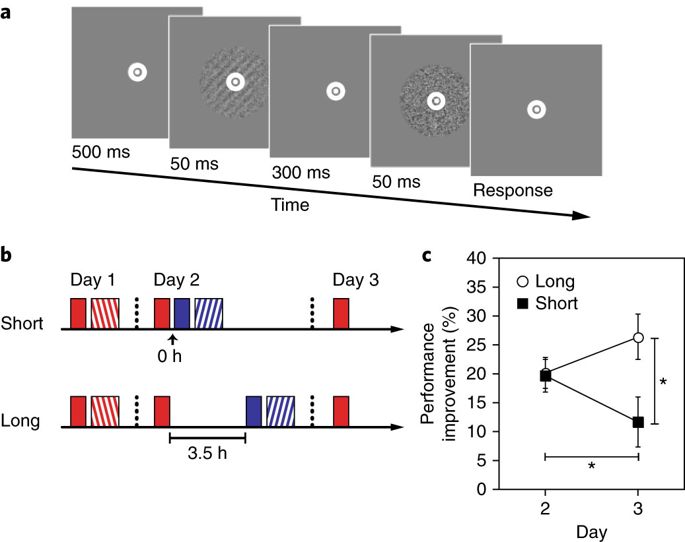Research Abstract
固定化と再固定化は行動学的・神経化学的な機序を共有している
Consolidation and reconsolidation share behavioural and neurochemical mechanisms
2018年7月9日 Nature Human Behaviour 2 : 7 doi: 10.1038/s41562-018-0366-8

符号化後の記憶痕跡は脆弱であり、「固定化」と呼ばれるプロセスによって安定化されるまでは、新たな学習によって容易に破壊される。しかし、固定化は記憶痕跡を永久に安定させるわけではないことが複数の研究から示唆されている。そうした研究の結果が支持するのは、「固定化済みの記憶の検索(再活性化)は記憶痕跡を不安定にし、さらなる固定化プロセス(再固定化)を経なければ、記憶痕跡は新たな学習によって破壊される」という説である。しかしながら、再活性化と再固定化がヒトの行動レベルでみられるか、また、固定化と再固定化に共通の機序があるかについては、未だ議論が分かれている。今回我々は、ヒトのスキル学習の1つである視覚学習において、再活性化後に再固定化がみられることを明らかにした。さらに、行動成績の変化と、磁気共鳴分光法( MRS)で測定した初期視覚領域における興奮性神経伝達物質グルタミン酸と抑制性神経伝達物質GABA(γ-アミノ酪酸)の濃度変化が、固定化中と再固定化中とで同様の経時変化を示すこともわかった。これらの結果は、ヒトにおける再活性化後の再固定化が、学習後の固定化と共通する行動学的・神経化学的機序をもつことを示している。
Corresponding Author
After encoding, memory traces are fragile and easily disrupted by new learning until they are stabilized through a process termed consolidation1,2. However, several studies have suggested that consolidation does not make memory traces permanently stable. The results of these studies support the theory that the retrieval of previously consolidated memory, termed reactivation, renders the memory traces labile again and subject to disruption by new learning unless they go through a further consolidation process, termed reconsolidation3,4,5,6,7,8. However, it remains controversial whether reactivation and reconsolidation occur at a human behavioural level9,10,11 and whether consolidation and reconsolidation have common mechanisms12,13. Here, we found that reconsolidation does occur after reactivation in visual perceptual learning14,15,16,17,18,19,20,21,22,23,24,25, a type of skill learning, in humans. Moreover, changes in behavioural performance, as well as in concentrations in the excitatory neurotransmitter glutamate and in the inhibitory neurotransmitter GABA (γ-aminobutyric acid), as measured by magnetic resonance spectroscopy, in early visual areas exhibit similar time courses during consolidation and reconsolidation. These results indicate that reconsolidation after reactivation and consolidation in humans share common behavioural and neurochemical mechanisms.

